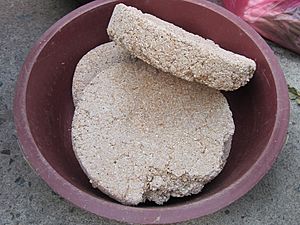Nuruk facts for kids
Nuruk (pronounced "noo-rook") is a very old and important ingredient from Korea. It's a special starter that helps make many traditional Korean drinks. Think of it like a secret ingredient that makes things ferment!
Nuruk is used to create popular Korean drinks like takju, cheongju, and soju. It's also key for a dish called Shindari, where it's mixed with rice. People have been using Nuruk all over Korea, even on Jeju Island, for a very long time.
To make Nuruk, people use grains like wheat, rice (both sticky and regular kinds), and barley. Wheat Nuruk is the most common type. The grains are first wet, then pressed into a big cake shape. This cake is then hung up to ferment for about 2 to 4 weeks. It needs to stay at a certain temperature until a special mold grows on it.
When Did Nuruk Start?
Nuruk has been used in Korea for a very long time. It dates back to the Three Kingdoms period, around the 3rd century CE. That's almost 2,000 years ago!
A similar starter called jiuqu was first made in China. This happened even earlier, around the 5th century BCE. Chinese history books first mention Nuruk being used in Korea in the year 1123 CE.
In the past, families would make their own Nuruk at home. They often did this in summer or autumn, especially in July. This was when the weather in Korea was warm, between 20 and 30 degrees Celsius. Since the 1920s, Nuruk has also been made in large factories.
What's Inside Nuruk?
Nuruk is full of tiny living things called microorganisms. These tiny helpers make the magic happen! They include different types of molds, bacteria, and yeasts.
- Molds: One important mold is Aspergillus oryzae. It makes an enzyme called amylase. This enzyme breaks down the starches in rice into sugars. Another mold, Rhizopus oryzae, makes enzymes called protease and lipase. These help break down fats and proteins in the rice. This allows the amylase to reach the starches inside.
- Bacteria: Lactobacilli are a type of lactic acid bacteria found in Nuruk. They turn some of the sugars into lactic acid. This gives a special flavor.
- Yeasts: The main yeasts are Pichia anomala and Saccharomyces cerevisiae. These yeasts eat the sugars that the molds create. When they do this, they produce alcohol.
The types and amounts of these tiny helpers can change. It depends on where the Nuruk was made. For example, Nuruk from warmer, humid areas like Busan often has more lactic acid bacteria.
See also
 In Spanish: Nuruk para niños
In Spanish: Nuruk para niños


